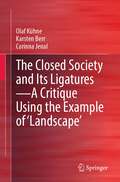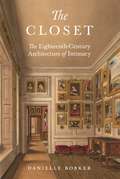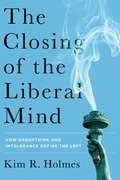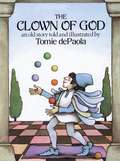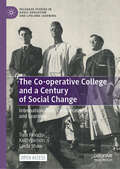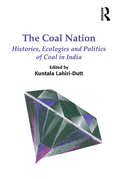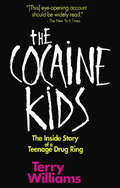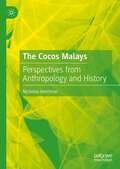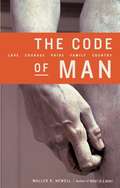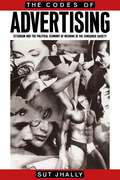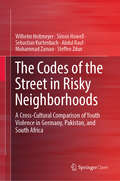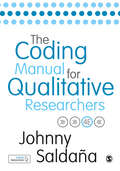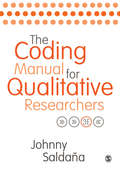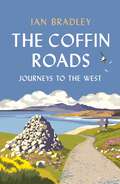- Table View
- List View
The Closed Society and Its Ligatures—A Critique Using the Example of 'Landscape'
by Olaf Kühne Corinna Jenal Karsten BerrIn the face of great challenges, utopian thinking is currently in vogue. The fact that utopias, with their ideas of an idealized target society, are not compatible with the basic features of an Open Society was already pointed out by Karl Popper in his book 'Die Offene Gesellschaft und ihre Feinde' (The Open Society and its Enemies) under the impression of National Socialism and Stalinism. In the present book, further forms of Closed Societies and the principal similarities (and differences) of their construction are examined. This is done by drawing on Ralf Dahrendorf's concept of life chances, in which he deals with the interaction of options and ligatures. The ambivalence of Dahrendorf's understanding of ligatures, since they restrict options on the one hand, but also give them meaning on the other, is resolved by a threefold differentiation: into ethical and moral, internally and externally directed, and explicit and implicit ligatures. While the former are capable of enabling life chances, the latter tend to limit them. Based on this, the authors elaborate on the landscape (side) consequences of various closed societies and how ill-suited they are for dealing with current challenges.
The Closet and the Cul-de-Sac: The Politics of Sexual Privacy in Northern California (Politics and Culture in Modern America)
by Clayton HowardThe right to privacy is a pivotal concept in the culture wars that have galvanized American politics for the past several decades. It has become a rallying point for political issues ranging from abortion to gay liberation to sex education. Yet this notion of privacy originated not only from legal arguments, nor solely from political movements on the left or the right, but instead from ambivalent moderates who valued both personal freedom and the preservation of social norms.In The Closet and the Cul-de-Sac, Clayton Howard chronicles the rise of sexual privacy as a fulcrum of American cultural politics. Beginning in the 1940s, public officials pursued an agenda that both promoted heterosexuality and made sexual privacy one of the state's key promises to its citizens. The 1944 G.I. Bill, for example, excluded gay veterans and enfranchised married ones in its dispersal of housing benefits. At the same time, officials required secluded bedrooms in new suburban homes and created educational campaigns designed to teach children respect for parents' privacy. In the following decades, measures such as these helped to concentrate middle-class families in the suburbs and gay men and lesbians in cities.In the 1960s and 1970s, the gay rights movement invoked privacy to attack repressive antigay laws, while social conservatives criticized tolerance for LGBT people as an assault on their own privacy. Many self-identified moderates, however, used identical rhetoric to distance themselves from both the discriminatory language of the religious right and the perceived excesses of the gay freedom struggle. Using the Bay Area as a case study, Howard places these moderates at the center of postwar American politics and shows how the region's burgeoning suburbs reacted to increasing gay activism in San Francisco. The Closet and the Cul-de-Sac offers specific examples of the ways in which government policies shaped many Americans' attitudes about sexuality and privacy and the ways in which citizens mobilized to reshape them.
The Closet: The Eighteenth-Century Architecture of Intimacy
by Danielle BobkerA literary and cultural history of the intimate space of the eighteenth-century closet—and how it fired the imaginations of Pepys, Sterne, Swift, and so many other writers Long before it was a hidden storage space or a metaphor for queer and trans shame, the closet was one of the most charged settings in English architecture. This private room provided seclusion for reading, writing, praying, dressing, and collecting—and for talking in select company. In their closets, kings and duchesses shared secrets with favorites, midwives and apothecaries dispensed remedies, and newly wealthy men and women expanded their social networks. In The Closet, Danielle Bobker presents a literary and cultural history of these sites of extrafamilial intimacy, revealing how, as they proliferated both in buildings and in books, closets also became powerful symbols of the unstable virtual intimacy of the first mass-medium of print. <P><P>Focused on the connections between status-conscious—and often awkward—interpersonal dynamics and an increasingly inclusive social and media landscape, The Closet examines dozens of historical and fictional encounters taking place in the various iterations of this room: courtly closets, bathing closets, prayer closets, privies, and the "moving closet" of the coach, among many others. In the process, the book conjures the intimate lives of well-known figures such as Samuel Pepys and Laurence Sterne, as well as less familiar ones such as Miss Hobart, a maid of honor at the Restoration court, and Lady Anne Acheson, Swift's patroness. <P><P>Turning finally to queer theory, The Closet discovers uncanny echoes of the eighteenth-century language of the closet in twenty-first-century coming-out narratives.Featuring more than thirty illustrations, The Closet offers a richly detailed and compelling account of an eighteenth-century setting and symbol of intimacy that continues to resonate today.
The Closing of the Liberal Mind: How Groupthink and Intolerance Define the Left
by Kim R. HolmesA former U.S. Assistant Secretary of State and currently a Distinguished Fellow at the Heritage Foundation, Kim R. Holmes surveys the state of liberalism in America today and finds that it is becoming its opposite-illiberalism-abandoning the precepts of open-mindedness and respect for individual rights, liberties, and the rule of law upon which the country was founded, and becoming instead an intolerant, rigidly dogmatic ideology that abhors dissent and stifles free speech. Tracing the new illiberalism historically to the radical Enlightenment, a movement that rejected the classic liberal ideas of the moderate Enlightenment that were prominent in the American Founding, Holmes argues that today's liberalism has forsaken its American roots, incorporating instead the authoritarian, anti-clerical, and anti-capitalist prejudices of the radical and largely European Left. The result is a closing of the American liberal mind. Where once freedom of speech and expression were sacrosanct, today liberalism employs speech codes, trigger warnings, boycotts, and shaming rituals to stifle freedom of thought, expression, and action. It is no longer appropriate to call it liberalism at all, but illiberalism-a set of ideas in politics, government, and popular culture that increasingly reflects authoritarian and even anti-democratic values, and which is devising new strategies of exclusiveness to eliminate certain ideas and people from the political process. Although illiberalism has always been a temptation for American liberals, lurking in the radical fringes of the Left, it is today the dominant ideology of progressive liberal circles. This makes it a new danger not only to the once venerable tradition of liberalism, but to the American nation itself, which needs a viable liberal tradition that pursues social and economic equality while respecting individual liberties.
The Clown of God
by Tomie DepaolaIn this retelling of the old French legend, a juggler offers to the Christ Child the only Christmas gift he has. Other books by this author are available in this library.
The Co-Housing Phenomenon: Environmental Alliance in Times of Changes (The Urban Book Series)
by Emanuele GiorgiThis book presents 50 case studies of contemporary co-housing projects spread all over the world to show how communities of shared living have become a global phenomenon that can serve as a tool to promote social and urban sustainability. By presenting evidence that shared housing experiences are capable of revitalizing sterile urban fabrics and promoting social sustainable practices, the volume situates co-housing experiences as microscale responses to the macroscale challenges posed by environmental degradation and the decline of communitarian ways of living.The volume also reviews the most famous typologies of shared living in different parts of the world across human history. By analyzing historical experiences in different regions of Africa, Americas, Asia, Europe and Oceania, the author shows that living together is part of a historical culture of sharing that is being rediscovered all over the world by people who activate public spaces, work in shared offices or live in contractual communities. The Co-Housing Phenomenon – Environmental Alliance in Times of Changes will be of interest to both professionals and scholars involved in urban design, urban planning and architecture, especially those in the field of sustainable urbanism. It will also be a valuable resource for public agents and civil society organizations dealing with housing, social, environmental and sustainability policies.
The Co-operative College and a Century of Social Change: Internationalism, Co-operativism and Learning (Palgrave Studies in Adult Education and Lifelong Learning)
by Linda Shaw Tom Woodin Keith VernonThis open access book explores the Co-operative College’s distinctive adult educational tradition over the past century as it provided education for co-operative leaders, employees and members in addition to developing a range of wider educational initiatives and ideas internationally. The Co-operative College is a British educational charity established in 1919, founded on co-operative principles. It played a crucial role in co-operative education in the British Empire and subsequently in the independent nations. In doing so, it brought together vocational and liberal education as well as educating members as part of a movement that fostered significant social change. It draws on original archival research at the National Co-operative Archive in Manchester as well as other material at the National Archives, Bishopsgate Institute and the British Library. Furthermore, the rich archives of the National Co-operative Archive allow for the development of a rich visual history of the movement to be explored.
The Coal Nation: Histories, Ecologies and Politics of Coal in India
by Kuntala Lahiri-DuttSocial science research is emerging on a range of issues around large and small-scale mining, connecting them to broader social, cultural, political, historical and economic factors rather than purely measuring the environmental impacts of mining. Within this broader context of global scholarly attention on extractive industries, this book explores two specific contexts: the cultural politics of coal and coal mining, within the context of one particular country, India, which is the third largest coal producer in the world. Both contexts are special; with its separate Ministry, coal occupies pride of place in contemporary India, shaping the energy future and influencing the economic and political milieu of the country. The supremacy attributed to coal mining in contemporary India represents how ’coal nationalism’ has replaced ’coal colonialism’ in the country, turning this commodity into an icon, a national symbol. In recent years the extraction of coal in forest-covered resource peripheries has dispossessed and pauperised many tribal and rural communities who have used these resource-rich lands for their livelihoods for generations. The combustion of coal to produce electricity constitutes the compelling need, and the factor that prevents the Indian state from fully engaging with the impending realities of a climate-changed future. All these reasons make the timing of this book of crucial importance. In particular, The Coal Nation explores the complex history of coal in India; from its colonial legacies to contemporary cultural and social impacts of mining; land ownership and moral resource rights; protective legislation for coal as well as for the indigenous and local communities; the question of legality, illegitimacy and illicit mining and of social justice. Presenting cutting-edge multidisciplinary social science research on coal and mining in India, The Coal Nation initiates a productive dialogue amongst academics and between them and activists.
The Coastal Tribes of the North-Eastern Bantu (Pokomo, Nyika, Teita): East Central Africa Part III
by A. H. PrinsRoutledge is proud to be re-issuing this landmark series in association with the International African Institute. The series, published between 1950 and 1977, brings together a wealth of previously un-co-ordinated material on the ethnic groupings and social conditions of African peoples. Concise, critical and (for its time) accurate, the Ethnographic Survey contains sections as follows: Physical Environment Linguistic Data Demography History & Traditions of Origin Nomenclature Grouping Cultural Features: Religion, Witchcraft, Birth, Initiation, Burial Social & Political Organization: Kinship, Marriage, Inheritance, Slavery, Land Tenure, Warfare & Justice Economy & Trade Domestic Architecture Each of the 50 volumes will be available to buy individually, and these are organized into regional sub-groups: East Central Africa, North-Eastern Africa, Southern Africa, West Central Africa, Western Africa, and Central Africa Belgian Congo. The volumes are supplemented with maps, available to view on routledge.com or available as a pdf from the publishers.
The Cocaine Diaries: A Venezuelan Prison Nightmare
by Jeff Farrell Paul Keany‘It won’t happen to me. That’s what I thought when I got on the plane to Venezuela. But it did – I got caught.’Caught smuggling half a million euros’ worth of cocaine, Paul Keany was sexually assaulted by Venezuelan anti-drugs officers before being sentenced to eight years in the notorious Los Teques prison outside Caracas. There he was plunged into a nightmarish world of coke-fuelled killings, gun battles, stabbings, extortion and forced hunger strikes until finally, just over two years into his sentence, he gained early parole and embarked on a daring escape from South America . . .Aided by his extensive prison diaries, Keany reveals the true horror of life inside Los Teques: a shocking underworld behind bars where inmates pay protection money to stay alive, prostitutes do the rounds and vast amounts of cocaine are smuggled in for cell-block bosses to sell on to prisoners for huge profits. The Cocaine Diaries is a remarkable story, told by Keany with honesty, courage and even humour, despite knowing that every day behind bars might have been his last.
The Cocaine Kids: The Inside Story Of A Teenage Drug Ring
by Terry WilliamsSince 1982, sociologist Terry Williams has spent days, weeks, and months "hanging out” with a teenage cocaine ring in cocaine bars, after-hours clubs, on street corners, in crack houses and in their homes. The picture he creates in The Cocaine Kids is the story behind the headlines. The lives of these young dealers in the fast lane of the underground economy emerge in depth and color on the pages of this book.
The Cocos Malays: Perspectives from Anthropology and History
by Nicholas HerrimanLooking at the past from an anthropological perspective, this book deploys and analyses a variety of anthropological concepts to understand the history of Cocos Malay society. Around 400 Cocos Malays reside on their remote Indian Ocean atoll, the Cocos Islands. Possessing a unique culture and dialect, they could be considered Australia's oldest Muslim and oldest Malay group. Yet their society only developed over the past two centuries. In the early 1800s, a European gathered about one hundred slaves from around Southeast Asia. After settling on Cocos, a dynasty of rulers tried to distinguish themselves as European kings. Under them, the Southeast Asians in the group toiled in the export of coconuts. But despite this, these Southeast Asians influenced and intermarried with the rulers. As a result, a Eurasian society developed. The Cocos Malays were initially implicated in Southeast Asian and wider Indian Ocean trade and communication networks. Later, this connectivity intensified through technologies such as telegraph cable and the Internet. This book uses the history of the Cocos Malays to explore questions of broader interest to anthropologists, such as how concepts from the overlap of history and anthropology ‘unlock’ the history of societies; how we can usefully combine the ‘indigenous’ concepts like “kerajaan” with internationally accepted concepts like class; and what is obscured when we use the concepts from the anthropology-history crossover to understand the past.
The Coddling of the American Mind: How Good Intentions and Bad Ideas Are Setting Up a Generation for Failure
by Jonathan Haidt Greg LukianoffSomething is going wrong on many college campuses in the last few years. Rates of anxiety, depression, and suicide are rising. Speakers are shouted down. Students and professors say they are walking on eggshells and afraid to speak honestly. How did this happen? <P><P>First Amendment expert Greg Lukianoff and social psychologist Jonathan Haidt show how the new problems on campus have their origins in three terrible ideas that have become increasingly woven into American childhood and education: what doesn’t kill you makes you weaker; always trust your feelings; and life is a battle between good people and evil people. These three Great Untruths are incompatible with basic psychological principles, as well as ancient wisdom from many cultures. They interfere with healthy development. Anyone who embraces these untruths—and the resulting culture of safetyism—is less likely to become an autonomous adult able to navigate the bumpy road of life. <P><P> Lukianoff and Haidt investigate the many social trends that have intersected to produce these untruths. They situate the conflicts on campus in the context of America’s rapidly rising political polarization, including a rise in hate crimes and off-campus provocation. They explore changes in childhood including the rise of fearful parenting, the decline of unsupervised play, and the new world of social media that has engulfed teenagers in the last decade. <P><P>This is a book for anyone who is confused by what is happening on college campuses today, or has children, or is concerned about the growing inability of Americans to live, work, and cooperate across party lines. <P><b>A New York Times Bestseller</b>
The Code of Man
by Waller R. Newell"In many ways," Waller R. Newell writes, "young men today are in deep spiritual trouble. But they are also yearning for a way back to the noblest ideals of American manhood." The Code of Man represents a deep and thought-provoking effort to help guide contemporary men back to those ideals, as embodied in what Newell calls the five paths to manliness: love, courage, pride, family, and country. At the dawn of the twenty-first century, he argues, we have grown so concerned about the roles of sex and violence in our society that we have forgotten the older virtues: romance and eros, courage and patriotism, the blend of love and bravery it takes to raise a family. In The Code of Man, he exhorts us to look to the traditional virtues of the past for inspiration. Contrasting the time-honored lessons of traditional voices -- Shakespeare and Abraham Lincoln, Jane Austen and Teddy Roosevelt -- with the chaotic signals emanating from sources like Eminem, video games like Thrill Kill, and Goth culture, Newell illustrates how we have come to associate courage with violence, "transgression" with wisdom. Most disturbing, he argues, the essential triumph of Western culture may have left us with a building reserve of untapped aggressive energy, and no consensus about how to channel it -- a situation that threatens to weaken us at the core. Seamlessly weaving together literary references from a diverse body of sources, Waller Newell offers an open-eyed look at what it means to be a man in America today, and a clarion call to recapture our traditions if we are to preserve our character as a society ... and avoid catastrophe.
The Codes of Advertising: Fetishism and the Political Economy of Meaning in the Consumer Society
by Sut JhallyThis book examines the commercial speech of advertising as a cultural phenomenon whose social significance far exceeds its economic influence. Jhally argues that by selling viewing time to advertisers, television converts audiences into laborers who "work" for the media in the same way that workers do in a factory. By watching commercial messages on TV, viewers actively create symbolic meaning, but also generate profit for the media in return for the wage of entertainment.
The Codes of the Street in Risky Neighborhoods: A Cross-Cultural Comparison of Youth Violence in Germany, Pakistan, and South Africa
by Wilhelm Heitmeyer Abdul Rauf Muhammad Zaman Sebastian Kurtenbach Simon Howell Steffen ZdunThis book presents a comparative look at the norms and attitudes related to youth violence. It aims to present a perspective outside of the typical Western context, through case studies comparing a developed / Western democracy (Germany), a country with a history of institutionalized violence (South Africa), and an emerging democracy that has experienced heavy terrorism (Pakistan). Building on earlier works, the research presented in this innovative volume provides new insights into the sociocultural context for shaping both young people's tolerance of and involvement in violence, depending on their environment. This volume covers: Research on interpersonal violence.Thorough review of the contribution of research on gangs, violence, neighborhoods and community.Analyses on violence-related norms of male juveniles (ages 16-21 years old) living in high-risk urban neighborhoods.Intense discussion of the concept of street code and its use.Application of street code concept to contexts outside the US.An integrating chapter focused on where the street code exists, and how it is modified or interpreted by young men. With a foreword by Jeffrey Ian Ross, this book aims to provide a broader context for research. It does so via a rigorous comparative methodology, presenting a framework that may be applied to future studies. This open access book will be of interest to researchers in criminology and criminal justice, as well as related fields such as sociology, demography, psychology, and public health.
The Codex Nuttall
by Zelia NuttallThe only value-priced, full-color edition of the pre-Columbian Mexican (Mixtec) book. Features 88 color plates of kings, gods, heroes, temples, sacrifices, and more. New introduction.
The Coding Manual for Qualitative Researchers
by Johnny SaldanaThis invaluable manual from world-renowned expert Johnny Saldaña illuminates the process of qualitative coding and provides clear, insightful guidance for qualitative researchers at all levels. The fourth edition includes a range of updates that build upon the huge success of the previous editions: A structural reformat has increased accessibility; the 3 sections from the previous edition are now spread over 15 chapters for easier sectional reference There are two new first cycle coding methods join the 33 others in the collection: Metaphor Coding and Themeing the Data: Categorically Includes a brand new companion website with links to SAGE journal articles, sample transcripts, links to CAQDAS sites, student exercises, links to video and digital content Analytic software screenshots and academic references have been updated, alongside several new figures added throughout the manual It remains the only book that looks specifically at coding qualitative data, as a core but often neglected skill that researchers and students alike need to effectively make sense of their data and to identify patterns, before they can analyse the material. Saldana presents a range of coding options with advantages and disadvantages to help researchers to choose the most appropriate approach for their project, reinforcing their perspective with real world examples, used to show step-by-step processes and to demonstrate important skills.
The Coding Manual for Qualitative Researchers
by Johnny SaldañaUnlock the full potential of your qualitative research projects with this invaluable manual from world-renowned authority Johnny Saldaña. This essential guide delves into the latest advancements in coding, including the integration of AI tools like ChatGPT-4, empowering researchers to enhance their data analysis processes and outcomes. This clearly updated edition offers: · Comprehensive Coverage: Explore over 35 coding methods, complete with datasets, software screenshots, and multidisciplinary academic references. · Global Appeal: Designed for an international readership, with inclusive data and real-world examples. · Practical Guidance: Clear, academically grounded advice that bridges the gap between data generation and analysis, ensuring credibility and trustworthiness. · Modern Relevance: Facilitates both manual and online coding, with detailed insights into CAQDAS and digital data handling. Ideal for students, researchers, and professionals in education, the social sciences, and beyond, this manual with its’ accompanying online resources is your go-to reference for mastering qualitative coding and data analysis in the AI era.
The Coding Manual for Qualitative Researchers
by Johnny SaldañaUnlock the full potential of your qualitative research projects with this invaluable manual from world-renowned authority Johnny Saldaña. This essential guide delves into the latest advancements in coding, including the integration of AI tools like ChatGPT-4, empowering researchers to enhance their data analysis processes and outcomes. This clearly updated edition offers: · Comprehensive Coverage: Explore over 35 coding methods, complete with datasets, software screenshots, and multidisciplinary academic references. · Global Appeal: Designed for an international readership, with inclusive data and real-world examples. · Practical Guidance: Clear, academically grounded advice that bridges the gap between data generation and analysis, ensuring credibility and trustworthiness. · Modern Relevance: Facilitates both manual and online coding, with detailed insights into CAQDAS and digital data handling. Ideal for students, researchers, and professionals in education, the social sciences, and beyond, this manual with its’ accompanying online resources is your go-to reference for mastering qualitative coding and data analysis in the AI era.
The Coding Manual for Qualitative Researchers
by Mr Johnny SaldanaLecturers, request your electronic inspection copy Johnny Saldaña’s unique and invaluable manual demystifies the qualitative coding process with a comprehensive assessment of different coding types, examples and exercises. The ideal reference for students, teachers, and practitioners of qualitative inquiry, it is essential reading across the social sciences and neatly guides you through the multiple approaches available for coding qualitative data. Its wide array of strategies, from the more straightforward to the more complex, is skillfully explained and carefully exemplified providing a complete toolkit of codes and skills that can be applied to any research project. For each code Saldaña provides information about the method's origin, gives a detailed description of the method, demonstrates its practical applications, and sets out a clearly illustrated example with analytic follow-up. Now with a companion website, the book is supported by: SAGE journal articles showing coding being applied to real research Sample transcripts highlighting coding techniques Links to CAQDAS sites to introduce relevant software Practical student exercises Links to video and digital content This international bestseller is an extremely usable, robust manual and is a must-have resource for qualitative researchers at all levels. Click here for a listing of Johnny Saldaña's upcoming workshops. Available with Perusall—an eBook that makes it easier to prepare for class Perusall is an award-winning eBook platform featuring social annotation tools that allow students and instructors to collaboratively mark up and discuss their SAGE textbook. Backed by research and supported by technological innovations developed at Harvard University, this process of learning through collaborative annotation keeps your students engaged and makes teaching easier and more effective. Learn more.
The Coding Manual for Qualitative Researchers: Theories, Concepts And Disciplinary Approaches To Tourism
by Johnny SaldanaThis invaluable manual from world-renowned expert Johnny Saldaña illuminates the process of qualitative coding and provides clear, insightful guidance for qualitative researchers at all levels. The fourth edition includes a range of updates that build upon the huge success of the previous editions: A structural reformat has increased accessibility; the 3 sections from the previous edition are now spread over 15 chapters for easier sectional reference There are two new first cycle coding methods join the 33 others in the collection: Metaphor Coding and Themeing the Data: Categorically Includes a brand new companion website with links to SAGE journal articles, sample transcripts, links to CAQDAS sites, student exercises, links to video and digital content Analytic software screenshots and academic references have been updated, alongside several new figures added throughout the manual It remains the only book that looks specifically at coding qualitative data, as a core but often neglected skill that researchers and students alike need to effectively make sense of their data and to identify patterns, before they can analyse the material. Saldana presents a range of coding options with advantages and disadvantages to help researchers to choose the most appropriate approach for their project, reinforcing their perspective with real world examples, used to show step-by-step processes and to demonstrate important skills.
The Coffee-House: A Cultural History
by Markman EllisHow the simple commodity of coffee came to rewrite the experience of metropolitan lifeWhen the first coffee-house opened in London in 1652, customers were bewildered by this strange new drink from Turkey. But those who tried coffee were soon won over. More coffee-houses were opened across London and, in the following decades, in America and Europe.For a hundred years the coffee-house occupied the centre of urban life. Merchants held auctions of goods, writers and poets conducted discussions, scientists demonstrated experiments and gave lectures, philanthropists deliberated reforms. Coffee-houses thus played a key role in the explosion of political, financial, scientific and literary change in the 18th century.In the 19th century the coffee-house declined, but the 1950s witnessed a dramatic revival in the popularity of coffee with the appearance of espresso machines and the `coffee bar', and the 1990s saw the arrival of retail chains like Starbucks.
The Coffee-House: A Cultural History
by Markman EllisHow the simple commodity of coffee came to rewrite the experience of metropolitan lifeWhen the first coffee-house opened in London in 1652, customers were bewildered by this strange new drink from Turkey. But those who tried coffee were soon won over. More coffee-houses were opened across London and, in the following decades, in America and Europe.For a hundred years the coffee-house occupied the centre of urban life. Merchants held auctions of goods, writers and poets conducted discussions, scientists demonstrated experiments and gave lectures, philanthropists deliberated reforms. Coffee-houses thus played a key role in the explosion of political, financial, scientific and literary change in the 18th century.In the 19th century the coffee-house declined, but the 1950s witnessed a dramatic revival in the popularity of coffee with the appearance of espresso machines and the `coffee bar', and the 1990s saw the arrival of retail chains like Starbucks.
The Coffin Roads: Journeys to the West
by Ian BradleyCoffin roads' along which bodies were carried for burial are a marked feature of the landscape of the Scottish Highlands and islands – many are now popular walking and cycling routes. This book journeys along eight coffin roads to discover and explore the distinctive traditions, beliefs and practices around dying, death and mourning in the communities which created and used them. The result is a fascinating snapshot into place and culture. After more than a century when death was very much a taboo subject, this book argues that aspects of the distinctive West Highland and Hebridean way of death and approach to dying and mourning may have something helpful and important to offer to us today. Routes covered in this book are: The Kilmartin Valley – the archetypal coffin road in this ritual landscape of the dead. The Street of the Dead on Iona – perhaps the best known coffin road in Scotland. Kilearnadil Graveyard, Jura – a perfect example of a Hebridean graveyard. The coffin road through Morvern to Keil Church, Lochaline - among the best defined and most evocative coffin roads today. The Green Isle, Loch Shiel, Ardnamurchan - the oldest continuously used burial place anywhere in Europe. The coffin road on Eigg – with its distinctive ‘piper’s cairn’ where the coffin of Donald MacQuarrie, the 'Great Piper of Eigg', was rested. The coffin road from Traigh Losgaintir to Loch Stocinis on Harris - popular with walkers and taken as the title for a best-selling thriller by Peter May. The coffin road on Barra – A detailed study of burial practices on Barra in the early 1950s provides a fascinating record of Hebridean attitudes to dying, death and mourning.
